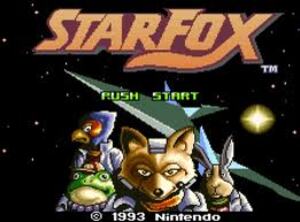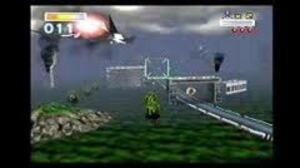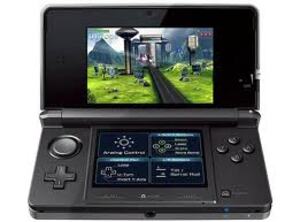
This week sees the release of Star Fox 64 3D. As you're no doubt aware, it's a remastering in the same vein as Ocarina of Time 3D, so updated visuals are naturally present. Given the updated hardware, Fox McCloud and the team will be appearing in true 3D for the first time. On the 3DS, a true sensation of depth should enhance the illusion of flying throughout the Lylat System, while the use of 3D means that players will be able to accurately judge the distance of incoming objects. Those enemies that appear in the distance will fall afoul of your laser fire, as you're able to strategically annihilate them as they attempt to return the favour. It's safe to say that the 3DS console's auto-stereoscopic 3D visuals were practically made for aerial shoot-'em-ups; it's a prime example of a genre that will genuinely benefit from the technology. Star Fox is a series that has been at the forefront of new gaming systems before, and this status as a pioneer of the shoot-em-up genre can be traced right back to its roots.
Shoot-'em-ups featuring aerial or space combat have been around for almost as long as videogames as a whole. From Asteroids and Space Invaders through to Gradius and R-Type, the formula of hopping into some ridiculous flying machine, evading an onslaught of enemy fire and hammering a button until everything else was dead was very much a tried and tested one. By the early 90s in fact, the only other genre that was as much a mainstay in the industry as space-based shoot-'em-ups was the 2D platformer. Like the platformer however, shoot-'em-ups hadn't evolved too much: sure, we'd gone from single-screen affairs to side-scrollers and they looked a lot prettier, but that's about it. But in 1993, a game launched that gave console shoot-'em-ups a kick up the backside, evolving and revolutionising the genre.
Subscribe to Nintendo Life on YouTube841k

That game was Star Fox.
Star Fox (or Starwing, as it was known in Europe) told the tale of protagonist Fox McCloud and the titular team of fighter pilots going up against the evil scientist/monkey, Andross. Players were tasked with flying through a series of levels, blasting incoming enemies, collecting power-ups and defeating bosses along the way. The gameplay itself wasn't what was revolutionary about Star Fox, however; players had been doing the same thing many times before. But in a time when games were for the most part perfectly content to let players move around on a two dimensional plane, Star Fox took almost everything we knew about console gaming and turned it on its head. This was largely down to Argonaut Games, the developer that in collaboration with Nintendo had designed the then-revolutionary Super FX chip. This chip impressively boosted the polygon rendering capabilities of the SNES; polygons still being very uncommon in console games at the time.

How it managed such a feat is something for you to Google on a boring Sunday afternoon. It's not the technical jargon and how it all worked that's important, but rather the result; and the result was spectacular. By using a third person 3D perspective, Star Fox was a title that not only looked jaw-dropping for the time but also took atmosphere within console games to a whole new echelon. The illusion of actually flying through each level and going into airborne combat with enemies appearing in the distance in front of the player brought with it a level of intensity and realism. Titles like Afterburner might have been using the same behind-the-ship perspective, but Star Fox's use of the new technical wizardry of polygons meant it looked infinitely better by comparison, and made the 2D side-scrolling shooters resemble ancient relics. Piloting a ship through danger-ridden skies no longer felt like a game — on the SNES, it felt real.
The SNES game's success and uncanny ability to up the ante and revolutionise an entire genre was subsequently duplicated in 1997, when Nintendo released Star Fox 64 (or Lylat Wars to our European readers). Of course, 3D gameplay was more commonplace by that time, but Star Fox 64 capitalised on the N64's processing power in the same way its predecessor had utilised the Super FX chip. Blocky and featureless enemy craft and buildings were eschewed in favour of asteroids, space debris and environments bursting with colour and textured to within an inch of their life. Soaring through space, on land or under sea with laser fire all around us as Andross' followers once again emerged over the horizon, we were in an instant reminded of why we fell in love with the original Star Fox four years prior. Star Fox 64's aptitude at making the player believe they were in the thick of the action was bolstered further by way of the N64 Rumble Pak. The player having explosions and hits send them tangible feedback only added to the immersion and atmosphere. Indeed, Star Fox 64 was not only the first Nintendo game to utilise a rumble feature but also came bundled with the device.
Since their N64 outing, the Star Fox team has starred in three titles that have differed in quality and deviated, arguably, from what made the first two entries so endearing. Luckily, the release of Star Fox 64 3D looks set to bring Star Fox back to its former glory. As mentioned above, it's a game that seems tailor-made for 3D visuals and the addition of being able to steer your craft by way of the 3DS gyroscope is icing on the cake; another mini-revolution, if you will. Despite this, you may bemoan the fact that it's the second remake Nintendo has released at retail in under three months. Whatever your stance, expect Star Fox to once again cement its position as a pioneer of shoot-em-up gaming when it lands on September 9th.





Comments 13
One of my favorite SNES games, I played this along with Street Fighter II Turbo probably the most as a kid. I really didn't appreciate it as much as I should have as a kid. Oh well, I do now and it proudly sits in my collection today and how can you not like like the music of Corneria? Classic tune!
I've never played the original StarFox probably. The only time I got a glimspe at it was on WarioWare: Smooth Moves! I wish Nintendo would release it on VC. I actually enjoyed Assault, I can't count how many hours me and my friends clocked on multiplayer. I didn't like Adventures or Command very much. Nevertheless, it still remains as my 3rd favourite series of all time!
Too bad they seem unable to make a good one anymore. Sin and Punishment is the new king. I still don't understand why Nintendo hasn't asked Treasure to make a Star Fox game...Can you imagine what they could do with a Nintendo sized budget?
I used to love to play Starfox on my SNES.
gyroscope controls
Man I wish Nintendo would release this on the VC already. This is one of the games I wanted most from the VC. I never owned a SNES back in the day but played it a bit at a friends. I remember how cool it was. Damn you Nintendo! Release this already.
Still waiting for the ultimate Star Fox game. Wii U perhaps? hope to see it down the line. Here is my tribute to this amazing series that caught my imagination back in 1993 and never let go: http://www.youtube.com/watch?v=9IP_w0cKJFU
/Marks another day on the wall for Starfox Adventures 2
With all the recent hype over Star fox 64 3D you'd think Nintendo would give us the original on VC.
I still don't buy that the Wii couldn't handle emulating the FX chip.
Such a missed opportunity.
Anybody here fans of Star fox Adventures?
Yeah I know it's not really a Star fox game but I still loved it.
Dunno why a lot of people hate SF Assault. It was one of my favorite SF games. Sure it didn't have a "classic" plot-line, but does it really matter? As long as the gameplay is great, that all that counts (to me).
@Link79 I've never played it, but it looks so fun. I want it like crazy .
I loved the multiplayer of Assault. The flow of ground to vehicle and back again was so manic and fun.
@Link79 I loved adventures but never finished it. That game had a fluctuating difficulty level.
@Link79: I dont think its the fact that they cant emulate the chip but rather who has the rights on the chip that is preventing Star Fox from coming to the VC.
this is maybe the one game that makes me wish I had a 3DS.
I freakin' loved the original on N64!
Show Comments
Leave A Comment
Hold on there, you need to login to post a comment...